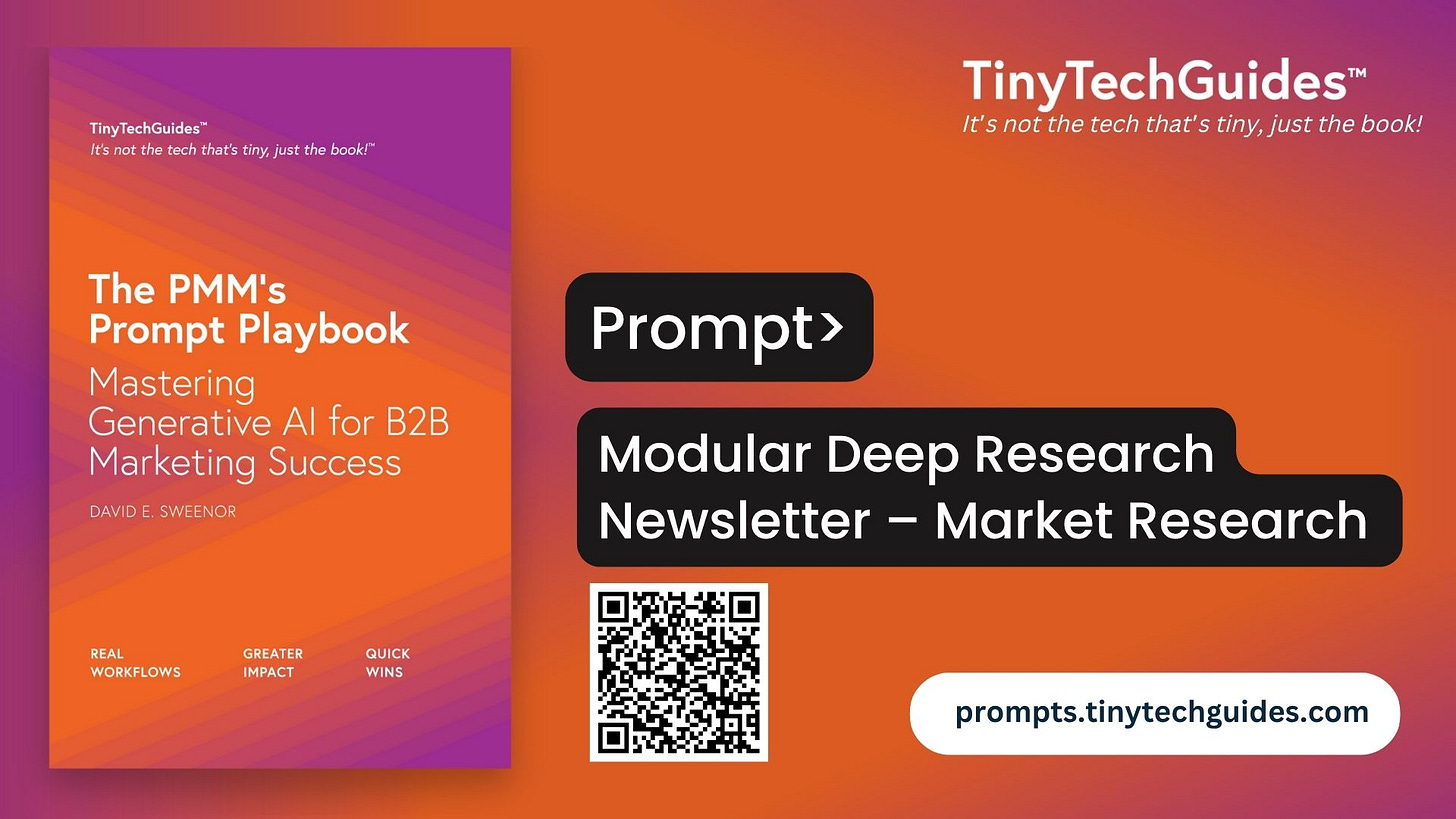How to Turn Deep Research into Actionable Market Intelligence
A repeatable workflow for product marketers to filter noise, uncover opportunities, and deliver insights that drive decisions.
This prompt is not part of The PMM’s Prompt Playbook which has 30 ready-to-use prompts. If you’re looking for more cut-and-paste prompts, join the Substack! Paid subscribers receive new cut-and-paste prompts every week.
Get the PMM’s Prompt Playbook and Modern B2B Marketing today!
Need help with product marketing or prompts? Let me know.
Modular Deep Research Newsletter Prompt Workflow – Market Research
created by prompts.tinytechguides.com
What this Workflow Does:
This workflow provides a structured method for conducting deep, weekly research on any market or strategic domain. It helps analysts or AI agents identify timely, high-value insights from trusted sources, filter them using targeted keywords, categorize findings by functional area, and summarize each item into concise, actionable takeaways. The result is a clean, executive-ready briefing that surfaces key implications, opportunities, risks, and emerging signals — all organized for decision-making, not just information overload.
Workflow Steps Summary:
Step 0: Define Inputs
Step 1: Source Discovery & Time Filtering
Step 2: Apply Strategic Keyword Filtering
Step 3: Categorize by Functional Area
Step 4: Extract Strategic Implications
Step 5: Compile Final Briefing
Step 0: Define Inputs (with Example Defaults)
Template:
{time_window = “past 7 days”}
{topic_scope = “target market or technology focus”}
{functional_categories = [”function1”, “function2”, “function3”, ...]}
{priority_keywords = [”keyword1”, “keyword2”, “keyword3”, ...]}
{publications = [”source1”, “source2”, “source3”, ...]}
{strategic_focus = “business implications, partnerships, risks, market shifts, etc.”}
{output_title = “Your Custom Briefing Title”}
{output_format = “Grouped by {functional_categories} with 2–3 bullet-point insights per group.”}
Step 1: Source Discovery & Time Filtering
Goal: Find fresh content from flagship sources in the last {time_window}.
#Role
You are a strategic market intelligence analyst focused on {topic_scope}.
#Context
You are conducting a research scan to identify meaningful developments from the past {time_window} across top-tier sources relevant to {topic_scope}.
#Task
Search for original, high-signal content (news, blogs, reports, research summaries) published in the last {time_window} from the following sources: {publications}.
Filter out reposts, summaries, or generic announcements. Focus on items that reflect movement in the market — new products, deals, use cases, funding, or research insights.
#Format
Return a list with:
(a) Title
(b) Date
(c) Source
(d) 2–3 sentence summary
(e) Link (if allowed)
#Tone
Concise, strategic, and factual. Avoid filler language.
Step 2: Apply Strategic Keyword Filtering
Goal: Isolate content that’s clearly aligned with priority trends using {priority_keywords}.
#Role
You are a market research analyst extracting trend-relevant intelligence from a set of headlines and summaries.
#Context
You have gathered a list of recent items from flagship sources. Now you must isolate those that align with key topics in {topic_scope}.
#Task
Using this list of keywords — {priority_keywords} — filter the research to only include content that directly references one or more of these keywords in a meaningful way.
Ignore items that reference them in passing or have no strategic or product impact.
#Format
For each matched item, include:
(a) Matched Keyword(s)
(b) Title
(c) Summary (max 3 lines)
(d) 1-sentence explanation of strategic relevance
#Tone
Crisp and executive-ready. Focus on signal, not fluff.
Step 3: Categorize by Functional Area
Goal: Group filtered content by {functional_categories}.
#Role
You are organizing strategic insights into functional categories for structured analysis.
#Context
You now have a list of filtered items relevant to {topic_scope}. Your goal is to bucket them into the most appropriate function area to enable targeted decision-making.
#Task
For each item, assign it to one of the following categories: {functional_categories}.
Use best judgment when multiple categories apply — pick the one with the most strategic fit.
#Format
Group by category name. Under each category, list:
(a) Title
(b) Source
(c) 1-line functional summary
(d) Why it belongs in this category
#Tone
Clear, structured, analytical.
Step 4: Extract Strategic Implications
Keep reading with a 7-day free trial
Subscribe to B2B Marketing Prompts by TinyTechGuides to keep reading this post and get 7 days of free access to the full post archives.


